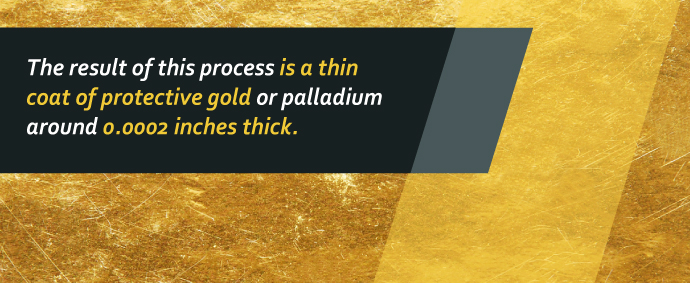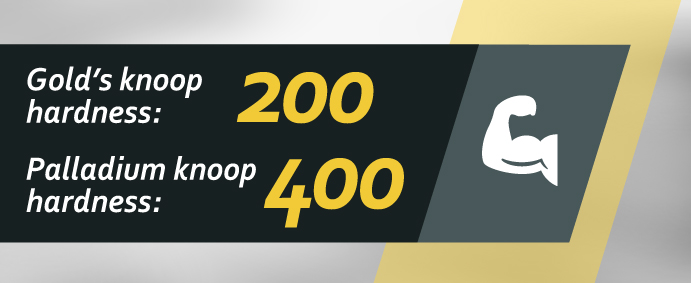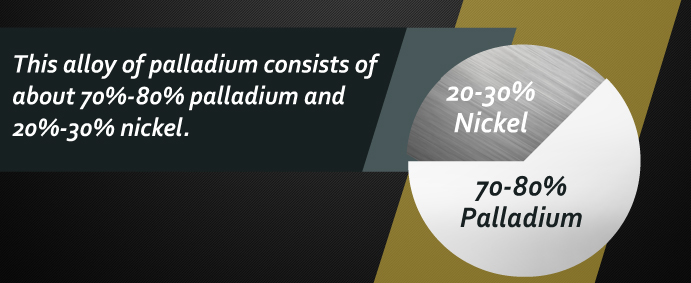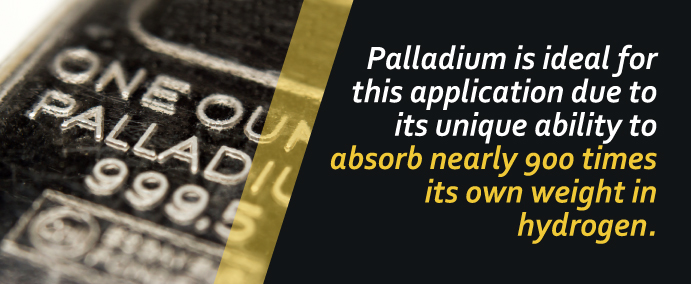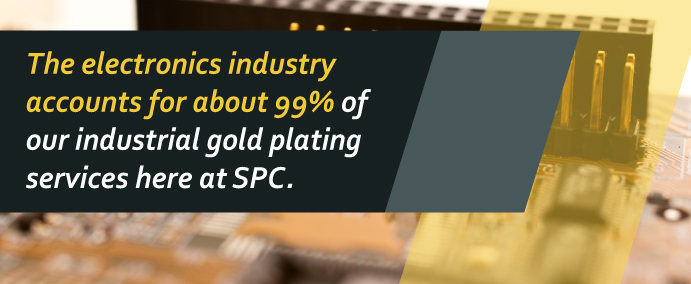While both are lauded in the jewelry industry for their beautiful appearances, there’s more to palladium and gold than their looks — they are extremely useful metals for a variety of plating applications. Lustrous gold is as useful as it is glamorous, and it is one of the common metals of the electronics industry. Silvery-white palladium offers a cheaper and more durable option that industries such as automotive, electronic and biomedical use in several applications.
In recent years, both gold and palladium have been treated as exchangeable materials. With the ever rising price of gold and labor, companies are in a constant search for the next best thing. For many, that next best thing has been palladium. While both materials are classified as rare precious metals and share numerous characteristics that make them very useful plating materials, palladium is much less expensive than gold.
As a result, companies across numerous industries have switched from gold to palladium plating, expecting similar results and properties. However, the two materials are far from the same in many respects.
Though treated as interchangeable, palladium and gold have vastly different qualities in terms of appearance, durability, cost and electrochemical properties. To understand these differences and appreciate the unique aspects of each of these metals, we’ve outlined their major features, from the processes involved in plating them to their strengths, weaknesses and applications.
Palladium and Gold Electroplating
Both palladium and gold are deposited onto a surface using an electroplating process. This process works in much the same way as most other metals:
- Cleaning: The object to be plated is first examined for cleanliness and put through a thorough cleaning process. Any stains, marks or other imperfections on the surface of the object act as a barrier to the electroplating process in one way or another. In many cases, it can result in an incomplete or defective coating that can peel or break off more easily. Cleaning the surface of the object thoroughly ensures a structurally sound, imperfection-free coat.
- Submersion: After cleaning, the object is submerged in an electrolytic bath in which gold or palladium ions are dissolved. In the case of palladium, the ions dissolved in the solution may all be palladium, or they may consist of a ratio of palladium and other metals. This depends entirely on whether palladium or a palladium alloy is to be deposited on the object. If an alloy is to be plated, proper portions of palladium and either cobalt or nickel are added to the electrolyte solution.
- Electroplating: Once the object is submerged, an electric current is run through the electrolyte solution. This current excites the ions and causes them to attract to the surface of the object. As a result, the ions bind at a chemical level to the surface of the object, creating a thin, uniform layer.
- Treating: After the electroplating process is completed, the finished product may go through one or more treating cycles. These treating cycles include heat treating to remove excess hydrogen from the plating layer, as well as drying cycles to remove excess solution from the surface of the material.
The result of this process is a thin coat of protective gold or palladium around 0.0002 inches thick. This coating is chemically bonded to the surface of the object, meaning that the external coating won’t peel or fall off of the surface, but it will instead wear down with time and use.
The properties of this coating, however, depend entirely on the material being plated onto the surface of the object. Whether it is palladium or gold, the coating deposited by electroplating lends different protective properties to the object.
Advantages of Palladium
Palladium, also known by its chemical symbol Pd, is a natural element that was discovered by William Hyde Wollaston in 1803. This relatively soft metal is recognized for its silver-white appearance, as well as its low density and melting point. Despite being a relatively inexpensive metal, palladium sports a host of useful properties.
Some of these beneficial attributes include the following:
- Comparatively inexpensive: Palladium is a relatively inexpensive material compared to other precious metals, and the price of this metal decreases as it is alloyed with other materials. These alloys, specifically palladium-nickel and palladium-cobalt, result in a functional, cost-effective plating.
- Corrosion resistant: Palladium is about as resistant to corrosion as gold, with a natural resistance against oxidation. Though not completely resistant to all elements, palladium’s resistance to most corrosive forces provides much needed protection against weather and friction.
- Relatively hard: Palladium is considered to be a softer metal, but it is still much harder and more durable than gold, which lends more protection against impact and a greater resistance to denting. Compared to gold’s knoop hardness of 200, Palladium has a knoop hardness of 400. This also means palladium is more resistant to wear and tear.
- Diffusion resistant: Unlike gold, palladium provides an excellent coating for copper. Copper will diffuse rapidly through gold, rendering the protective purpose of the gold coating useless. Palladium does not react this way, and so palladium, or palladium-nickel, is commonly used as a coating for copper objects.
Disadvantages of Palladium
While palladium is a very useful material and has several advantages over gold, palladium isn’t a perfect replacement for its precious competitor. Palladium’s less favorable qualities include:
- Reduced heat resistance: Palladium tends to discolor under extreme heat, and it doesn’t have the same heat transfer abilities as gold. This makes it less suitable for consistently hot environments or applications. Palladium also has a lower melting point than gold, meaning it is easier for it to deform under extreme heat.
- Not acid resistant: Though resistant to most corrosive forces, palladium does have a particular weakness to strong acids. This vulnerability to strong acids limits the types of applications in which palladium can be used.
- More prone to cracking: Because of its hardness, palladium tends to be more prone to cracking than gold when placed under stress. Even a single crack can reduce the integrity of the part as a whole, which is why this is such a problem. This disadvantage is often alleviated with the use of a palladium alloy instead of pure palladium.
Palladium Alloy Options
Palladium alloy options provide an excellent way around pure palladium’s tendency to crack under stress. By combining palladium with a more malleable metal, like nickel or cobalt, the material can be softened enough to prevent cracking. In addition to being more crack resistant, these popular palladium alloys are also cheaper than pure palladium, reducing the cost of the plating significantly.
The most popular palladium alloys include the following:
- Palladium-nickel: This alloy of palladium consists of about 70 to 80 percent palladium and 20 to 30 percent nickel. Palladium-nickel plating services promote this alloy as a much more stress-resistant option to palladium, one that is less susceptible to cracking than palladium. Also, palladium-nickel is more resistant to heat and galvanic corrosion than palladium, while also offering reduced porosity and excellent solderability.
- Palladium-cobalt: Another alloy option for palladium is palladium-cobalt. This alternative to palladium-nickel found popularity in the connector industry for its improved capacity to be deposited in greater thicknesses. Palladium-cobalt plating services also tend to note the fact that palladium-cobalt often performs better and at a lower cost than palladium-nickel. Additionally, it’s up to 90 percent cheaper than gold. Today, palladium-cobalt is most often used in cell phones and computer batteries, as well as semiconductor packages.
Applications of Palladium and Palladium Alloys
Like gold, palladium and its alloys are extremely useful and versatile in a number of applications. Some of the more popular applications of palladium and its alloys include:
- Electronics industry: Palladium is frequently used in the electronics industry as a plating for connectors and contacts. This is because of its low surface contact resistance. Often, a palladium-nickel alloy is plated on a connector surface before adding a flash of gold — this combination provides a low-cost, yet highly effective solution.
- Automotive: Car manufacturers use palladium as a plating for numerous parts, but most notable of these applications is the use of palladium within catalytic converters, which transform toxic materials within engine exhaust into nontoxic substances. Palladium is ideal for this application due to its unique ability to absorb nearly 900 times its own weight in hydrogen.
- Biomedical: Like gold, palladium is a nontoxic material, making it an ideal choice for medical and dental products. Crowns, inlays and bridges in particular are popular palladium applications, providing an alternative to gold.
Advantages of Gold
Gold has been a part of humanity’s history for centuries as a symbol of status and wealth. In more recent years, however, its usefulness has expanded to include plating for numerous industrial applications. Gold tends to be preferred for numerous plating applications over palladium, and it’s not just because of its beautiful luster or high value. Gold has a number of chemical properties that make it an extremely versatile and useful metal. Some of these useful properties include the following:
- Corrosion resistance: Gold plating serves as a superior protective coating, protecting the underlying substrate from corrosion. Gold can stand up to all types of climates and environments, helping prolong the lifespan of the part and reduce the need for maintenance due to wear.
- Electrical conductivity: Plating made from gold also serves as an excellent conductor for electricity. This makes the material ideal as a plating for electrical connectors and other applications where electricity must move from one area to another.
- Thermal conductivity: In addition to being electrically conductive, gold is also thermally conductive, meaning that it can transfer heat very easily. This helps to disperse heat away from the substrate and reduce the effects of heat on the function of the part.
- Long-lasting: Gold plating often lasts much longer than other alternatives, like palladium and its alloys, making it a better long-term investment.
Disadvantages of Gold
Though it creates a lovely shine, gold is far from a perfect plating. Though the material offers numerous advantages, it does have certain limitations that make it unsuitable for certain applications. Some of these disadvantageous properties include:
- Relatively high cost: Although it is a useful and beautiful product, the high demand of gold means it is a fairly expensive material to plate. The cost is often prohibitive for larger applications or mass production, making it more cost-effective for manufacturers to turn to alternative resources.
- Relatively soft: Gold is a relatively soft metal. Though it is resistant to corrosion and most wear, it does not handle impact as well as other materials. This makes it highly unsuitable for applications needing a strong outer coating.
Applications of Gold
The advantages of gold make it an ideal plating material for numerous applications. Some of the more common applications for gold plating include the following:
- Electronics industry: The electrical properties of gold make it an extremely useful material for the electronics industry. Gold is commonly found in electrical components and products from connectors to switches. One of the most common applications is the circuit board, where gold can be used for semiconductors. All in all, the electronics industry accounts for about 99 percent of our industrial gold plating services here at SPC.
- Biomedical industry: Gold plating is commonly used in medical and dental applications, both for prosthetics and for medical equipment. Gold teeth are fairly common, as are the gold components in pacemakers and other implants. Gold can also be found in medical machinery, such as scanners and surgical equipment.
- Aerospace industry: Gold’s anti-corrosive and heat-protective properties make it extremely useful in the aerospace industry. Parts in rockets and planes handle extreme heat on a regular basis, and many parts encounter a great deal of corrosive material in the atmosphere.
Palladium and Gold Plating Services at SPC
When it comes precious metal plating services, there is no better provider than Sharretts Plating Company. Whether you are looking for a quality palladium plating service or a provider skilled in gold plating, we can help.
With over 90 years of industry experience, SPC is a metal finishing company well-versed in precious metal plating services. We can guarantee that your parts will come back with the best gold, palladium or palladium alloy plating money can buy. Additionally, our processes are designed to minimize material waste and environmental impact, reducing the cost of the processes to you, your company and the environment as a whole.
In addition to our quality services, we can offer you with a consultative experience you can’t find anywhere else. Our experienced consultants can visit your company on-site and go through all of the options available to you before you place your plating order. Even better, we can take a look at your design and provide you with suggestions on how to improve on your plating. We’ll do this even if you decide not to use us as your plating provider — that’s how much we care about your success.
If you’re considering precious metal plating companies for your next project, contact SPC today to speak with an experienced plating consultant about your precious metal electroplating needs. Can’t wait to get started? Get a free, no-obligation quote from our website.


